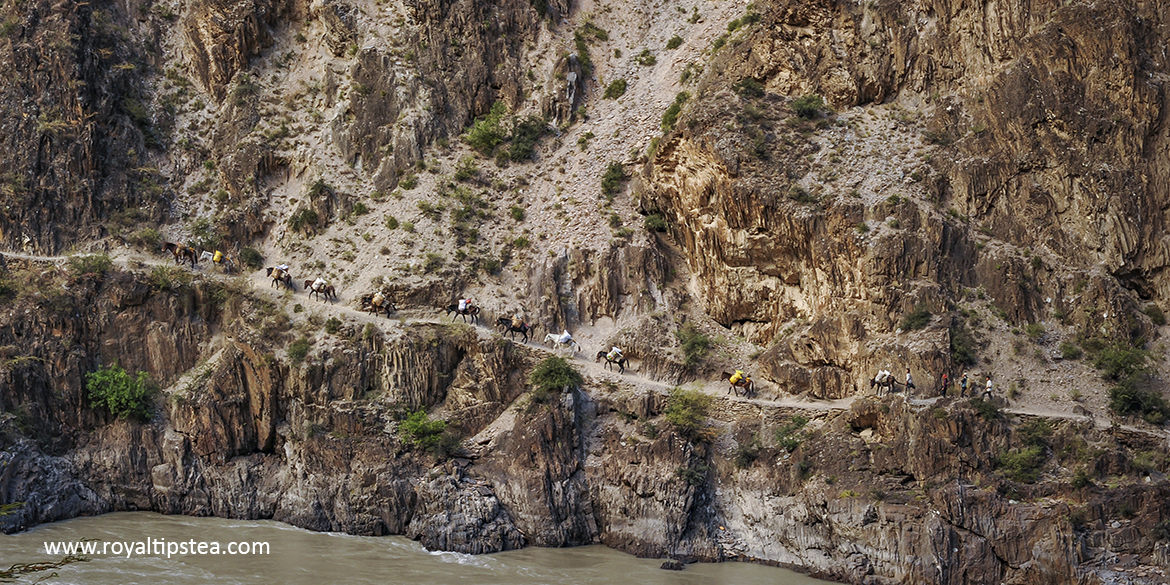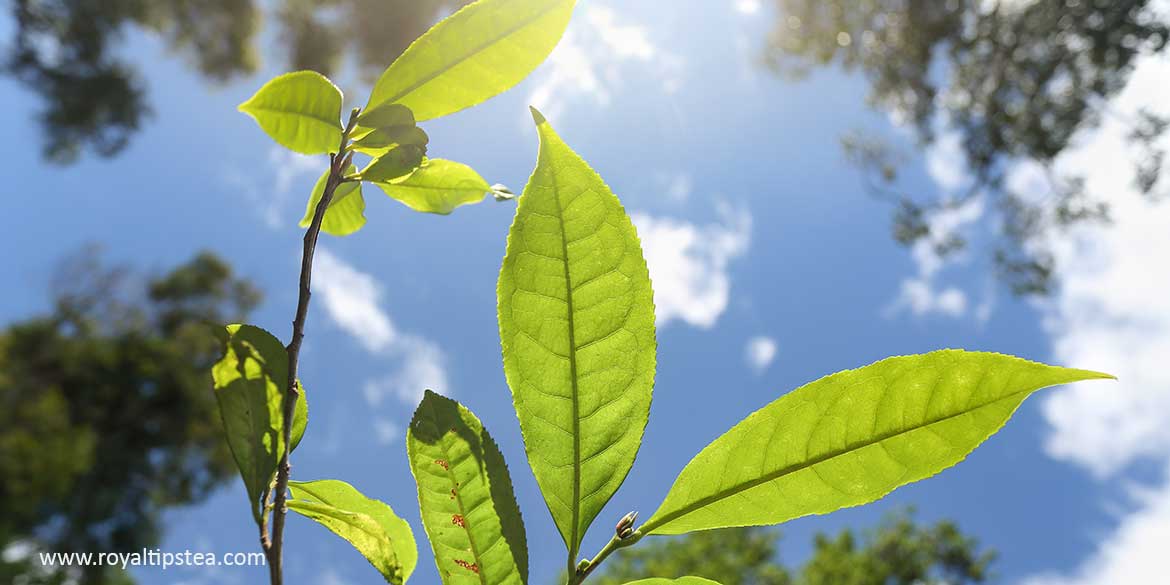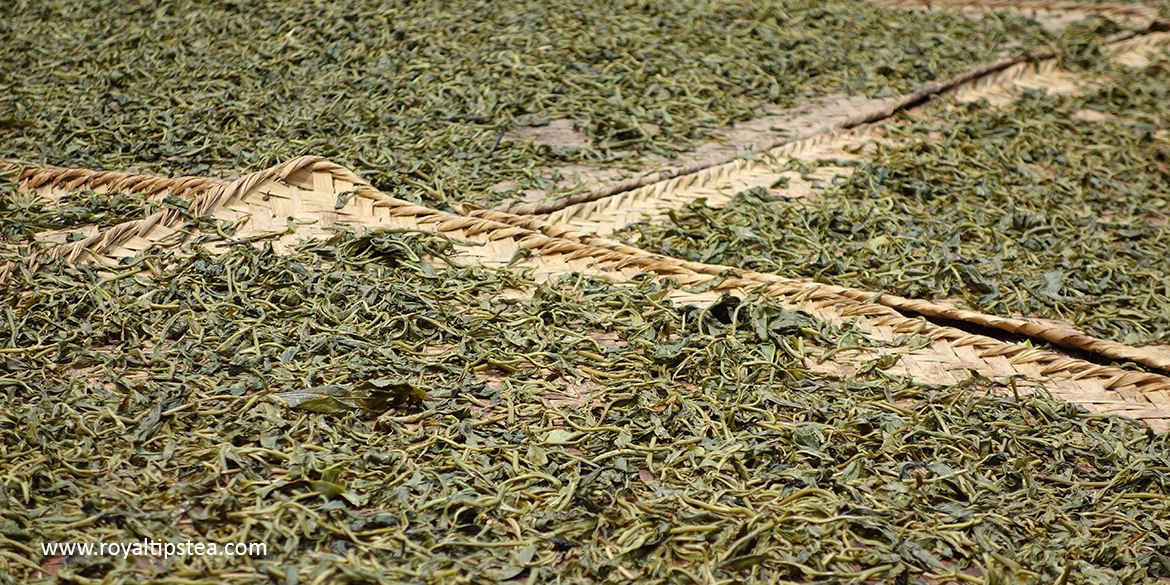The post Why do Wild Trees from Yunnan produce best Pu-erh Tea? first appeared on Blog Royal Tips.
]]>All Pu-erh Teas are Assamica Variety
The southern, sub-tropical, forested region of Yunnan province is where the story of tea began. It was here in the humid foothills of the Himalayas that the plant is thought to have first grown thousands of years ago. And, although the small-leafed Camellia sinensis sinensis (Chinese Camellia sinensis) grows in other parts of China, it is the large-leafed Camellia sinensis assamica that grows as a native to Yunnan. It is the same branch of the tea family that is found in northern Vietnam, northern Loas, Myanmar and Assam, for the birthplace of the tea plant – what is often called the ‘Himalayan corridor of diversity’ – includes those regions as well as southern Yunnan.
The ancient wild trees that are so important to the production of quality Puerh teas today are all assamicas. In thick forest areas, where they have been left to grow organically for hundreds of years, they have climbed up and up towards the sky and a few reach heights of 20 to 30 metres. In more open areas, where they do not struggle for light, the trees stretch their branches sideways and look more like large apple trees. Their strong thick trunks are sometimes single, sometimes multiple, and their leaves are long and broad, big enough to stretch from your fingertips to your elbow.
The oldest trees are found in the jungles of Xishuangbanna, which borders Laos and Myanmar, and also in Lincang district, which lies a little further north west on the border with Myanmar, and in Simao district, close to the town of Puerh. People in several of the most famous areas claim to have the oldest, tallest ‘king of trees’ growing on their local mountain.
Classification of Tea Trees according to their Age
The tea trees are divided into three groups – ancient or antique trees, old trees, and new trees.
– ‘Ancient’ or ‘antique’ refers to trees that are over 100 years old and have been left to grow wild, with no cultivation, no fertilization, and no use of pesticides, etc.
– ‘Old’ refers to trees that are between 30 and 100 years old and are usually semi-wild, having been grown from seeds or cuttings from older wild trees and then planted and cultivated in tea gardens.
– ‘New’ refers to young bushes that have been planted much more recently on tea farms and gardens.
The most valued are of course the oldest wild trees for, as they have grown organically, they have pushed their roots deep down into the earth to seek out nutrients and water and have had to struggle to survive. The stress they have experienced in that difficult situation gives the leaves a finer, more subtle, more aromatic flavour than teas from bushes that have not had to work hard to survive.
To gather the new leaf shoots and buds from the oldest wild trees, farmers often have to walk long distances into the forests carrying their baskets on their backs. When they reach the trees, they must climb up into the branches and balance carefully while plucking off the leaves. To protect the quality of the teas from the most precious of the ancient trees, they are usually only picked once a year in the spring, and each tree yields only two or three kilograms of tea each year.
The post Why do Wild Trees from Yunnan produce best Pu-erh Tea? first appeared on Blog Royal Tips.
]]>The post The Origin of Pu-erh Tea. Sheng and Shu Pu-erh first appeared on Blog Royal Tips.
]]>
Origins and history of Pu-erh Tea
By the 6th century AD, tea from Yunnan was being transported to Lhasa where it had become a popular food supplement for the Tibetan people whose diet at the high altitudes was limited. Because the transportation of loose tea caused enormous logistical difficulties, green tea made in Yunnan was compressed into cakes before being loaded onto ponies, yaks and mules. The preferred shape was a round flat disc of approximately 357 grams and these were stacked inside layers of bamboo leaves.
The journey to Tibet took six to eight months through heavy rain, thick foggy mists, and blazing summer sun. During the laborious journey, the tea absorbed humidity and this activated the micro-flora in the tea and provoked a slow bacterial fermentation. The micro-organisms found their way into the tea because they were present in the air of Yunnan’s dense tea forests, settled on the leaves of the tea trees and were in the tea after processing. The humidity and warm temperatures on the journey to Tibet activated a natural fermentation process, which continued during storage of the teas in Lhasa.

In 1972 there was a new development. The best Pu-erh teas need seven to ten years to develop their more mellow character and, in order to speed up the fermentation process and make more tea available more quickly, the Menghai Tea Factory and the Kunming Tea Factory adapted the method of wet piling, called ‘wo dui’, used in Guangxi province since the 18th century. Mass production of this ‘ripened’ tea began in 1975, and most teas made by this method are stored for only two or three years before being ready to drink.
Pu-erh tea made by the traditional method of slow aging is called Sheng (Raw) Pu-erh; tea made by the modern wet-piled method is called Shu (Ripe, Ripened, or Cooked) Pu-erh.
Sheng Pu-erh (Raw Pu-erh tea)
To make Raw Pu-erh, tea buds and leaves are picked, withered in the shade for a few hours, panned at a low temperature to remove some of the water content and soften the leaves, rolled by hand on bamboo baskets, and dried in the sun. As it dries, this ‘maocha’ (raw or rough tea) oxidises slowly and darkens from bright green to a mixture of green-brown and downy silvery buds. This oxidation happens because, although the tea has been panned before rolling, the heat treatment is not enough to kill all the enzymes in the leaf, and those that remain, activate slow oxidation as the leaves dry slowly in the sun. During the normal production of green tea, the tea is dried much more quickly in the wok, panning machine or oven and so no oxidation takes place.

Maocha can be sold and drunk as it is, but to make Pu-erh, it is steamed in a cylindrical can with holes in the base that allow the steam to pass up through the tea. A linen or cotton bag is slipped over the cylinder and flipped upside down so that the tea falls into the bag and the cylinder is removed. A little paper identity tag, called a ‘nei fei’ which indicates the factory name and the brand, is placed amongst the leaves, and the bag of tea is placed on a large concave stone. The sides of the bag are twisted and pressed down onto the tea to work it down into the bottom of the bag and form a neat compressed disc that is very even around the edges and round like a biscuit. As the bag is twisted and tightened, the knot of fabric makes a round indentation in the centre of the tea’s surface. The bag with the tea inside is then placed on a wooden plank under a very heavy stone and the tea maker climbs onto the stone and uses his body weight to compress the tea. In large factories, the pressing is carried out using hydraulic presses or a mechanically operated stone. The bag is then removed and the cake of tea is air-dried, then wrapped and stored in temperature-controlled and humidity-controlled conditions.
The wrapping paper gives the year the tea was made (and sometimes the season), the region, the grade of leaves used, the plant varietal or cultivar, and the name of the factory. Inside the wrapper is a slip of paper called a “Nei Piao”, which gives further information about the factory, the brand and the tea itself.
Shu Pu-erh (Cooked or Ripe Pu-erh tea)
Shu Pu-erh is also made using maocha, which is processed in exactly the same way as for Sheng Pu-erh. But, instead of being lightly steamed, the tea is mixed with water, heaped, covered and stored in a humid, warm warehouse for several months. From time to time, the covers are removed, the tea is mixed and turned, and the covers are then replaced. Careful control of the humidity, temperature and the rate of the fermentation are crucial to the production of good Shu Pu-erh. When it is ready, the tea is dried and then sold loose, aged loose, or compressed in the same way as Sheng Pu-erh into round cakes, rectangles or shaped like pumpkins, birds nests, or mushrooms. Shu Pu-erh is rarely aged longer than ten years.
The post The Origin of Pu-erh Tea. Sheng and Shu Pu-erh first appeared on Blog Royal Tips.
]]>